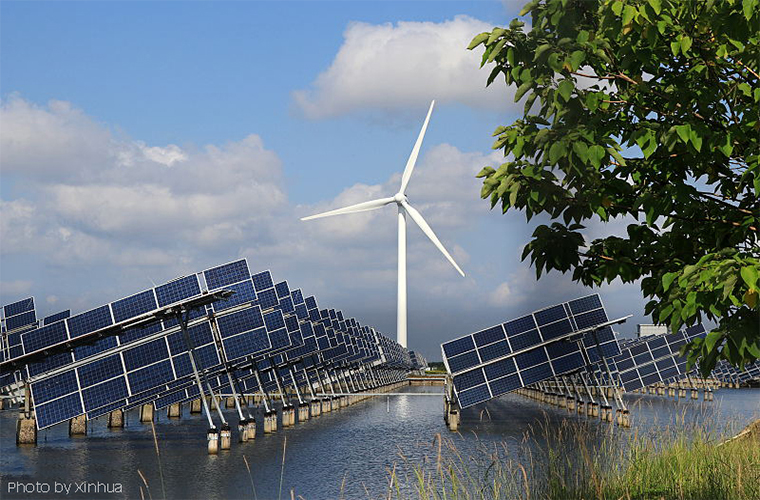



▲ A new project that combines solar and wind power generation with fish farming is established off the coast in Taidong, Jiangsu province. [Photo/Xinhua]
To implement the “National Climate Change Adaptation Strategy 2035” and continue the implementation of the “Urban Climate Change Resilience Action Plan”, actively explore the construction path and model of climate-resilient cities, and effectively enhance urban resilience to climate change, China has issued the “Notice on Deepening the Pilot Construction of Climate-Resilient Cities” for the promotion of the pilot construction.
1. Working Principles.
1.1 Adhere to risk orientation and adapt to local conditions.
Strengthen climate risk awareness, based on the analysis of the global and regional climate and guided by the proactive presentation and mitigation of major climate risks faced by the cities. Leverage the initiative and proactivity of pilot cities, tailor the strategies to urban conditions, and highlight the characteristics of each city to steadily promote the construction of climate-resilient cities.
1.2 Adhere to comprehensive coordination with emphasis on priority.
Establish and improve the leadership and coordination mechanism for the pilot construction of climate-resilient cities. Coordinate efforts and work in synergy, define the objectives and tasks for the climate-resilient cities on the basis of in-depth analysis and assessment of adverse impacts and risks from climate change, and highlight the main tasks, key measures, and major projects to promote a substantial increase in the climate resilience of pilot cities.
1.3 Adhere to categorized instruction and innovative exploration.
Provide categorized instruction for the pilot construction of climate-resilient cities based on various factors including regions, populations, urban functional positioning, types of climate risks, etc. Encourage pilot cities to take the lead in innovation to explore the construction mechanisms and models for the climate-resilient cities, so as to develop replicable and popularized experiences for other cities.
1.4 Adhere to public participation for nationwide collaboration.
Comprehensively raise awareness for the importance of climate-resilient city construction, widely mobilize government departments, enterprises, institutions, social organizations, and the general public to participate in the collaborative efforts. Instruct and integrate advantageous resources, strengthen support and capacity-building for climate resilience, and create a positive atmosphere for the construction of climate-resilient cities.
2. Working Objectives.
Taking into consideration factors such as climate risk types, national geographical features, urban functions and populations, etc., pilot construction projects of climate-resilient cities should be conducted nationwide to actively explore and summarize the paths and models for the construction of climate-resilient cities, and enhance urban resilience to climate change.
By 2025, a group of pilot cities with a strong foundation, effective organizational support, and demonstrative effect will be selected on a priority basis for early implementation. The construction of climate-resilient cities should be incorporated into the main tasks and economic and social development plan of the pilot cities. Mechanisms for climate resilience will be improved, and resilient actions in key areas should be effectively carried out, leading to valuable construction experiences in climate-resilient cities.
By 2035, the number of pilot cities will increase to about 100, and the pilot construction experiences of climate-resilient cities should be effectively promoted and further consolidated. The concept of climate-resilient cities should be widely popularized, and urban climate risk evaluation and climate resilience capacity will be significantly enhanced. The pilot construction experience of climate-resilient cities will be comprehensively promoted, and cities at or above the prefectural level will embark on comprehensive climate-resilient construction.
3. Main Tasks.
3.1 Improve the urban governance system for climate resilience.
Strengthen the coordination and instruction for the construction of climate-resilient cities, and establish and improve the governance and coordination mechanism for the pilot construction of climate-resilient cities. Develop the implementation plan for the construction of pilot climate-resilient cities, and integrate the plan into various levels and types of urban planning and main tasks for creating “Beautiful cities”. Establish a working system encompassing climate system observation, impact and risk assessment, comprehensive resilience actions, and feedback on effectiveness, as well as an information-sharing mechanism and platform for climate-resilient cities. Improve the guarantee mechanism and complementary policies for climate resilience, in terms of fiscal, financial, and technological support. And establish an evaluation and assessment mechanism and integrate it into the ecological and beautiful city assessment system.
3.2 Strengthen the impact and risk assessment of climate change in cities.
Build a high-precision database for urban climate change monitoring, forecasting, and prediction, and conduct a comprehensive analysis of urban climate features as well as the heat island effect, rain island effect, dry island effect, and haze island effect. Explore fine-scale quantitative monitoring and assessment, prediction, and attribution analysis of climate change impacts and risks. Establish a cross-departmental working mechanism for joint consultation and assessment of climate risks. Strengthen the comprehensive prevention and control of geological disasters in regions significantly affected by climate change and advance the impact analysis and risk assessment of coastal cities. Effectively link the regular meteorological hazard investigation with periodic comprehensive risk surveys and draw city climate risk maps.
Source:<https://www.gov.cn/zhengce/zhengceku/202308/content_6900892.htm>
<https://language.chinadaily.com.cn/a/202206/16/WS62aac525a310fd2b29e631f1.html>
Edited and Translated by Guo Xinxin